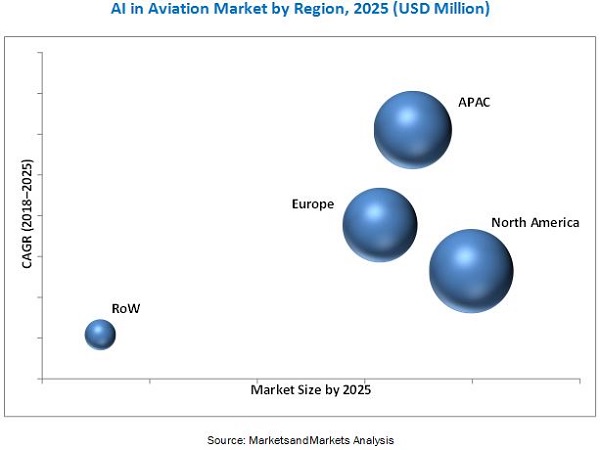Practices › Information System & Analytics › Artificial Intelligence (AI) in Aviation Market
Artificial Intelligence (AI) in Aviation Market
The global artificial intelligence (AI) in aviation market is expected to be valued at USD 152.4 Million in 2018 and is likely to reach USD 2,222.5 Million by 2025, at a CAGR of 46.65% between 2018 and 2025. The major factors driving the growth of the AI in aviation market include the use of big data in the aerospace industry, significant increase in capital investments by aviation companies, and rising adoption of cloud-based applications and services in the aviation industry.
In this report, the AI in aviation market has been segmented on the basis of technology, offering, application, and geography. Among all offerings, software holds the largest share of the overall AI in aviation market. This is owing to the developments in AI software for applications such as surveillance, flight operations, and airport operations. AI systems comprise software including application program interfaces, such as language, speech, vision, and sensor data, along with machine learning algorithms, to realize various applications in the aviation industry.
Among all technologies, machine learning is likely to hold the largest share of the AI in aviation market during forecast period. Machine learning’s ability to collect and handle big data, along with its increased ability to perform previously impossible calculations, is fueling the growth of the market for machine learning.
Among all applications, virtual assistants are expected to hold the largest share of the AI in aviation market throughout the forecast period. AI-based virtual assistants help airline companies improve their productivity and increase the efficiency of pilots by reducing recurring works, such as changing radio channels, reading wind forecasts, and providing position information on requests. These recurring jobs are taken care by the AI-enabled virtual assistants. Garmin (US) offers AI-enabled audio panels that help pilots operate these panels without taking their hands off the controls. Furthermore, virtual assistants also help airline companies improve customer services. They can provide instant answers to simple questions pertaining to flight status and services/offerings (audio, video, Wi-Fi), while customer representatives can attend to more important issues, enhancing customer experience. Virtual assistants are used at several airports to serve air travelers. For example, a virtual assistant is placed in the security line at the Barcelona (Spain) airport to help passengers with the security instructions and steps required to check in. Considering the benefits offered by these systems, a large-scale adoption of virtual assistants by airline companies is expected in the near future.

The AI in aviation market in APAC is expected to grow at a high rate between 2018 and 2025. This growth can be attributed to the huge demand for AI technologies from countries such as China and Japan to increase efficiency of their aviation sector. For example, the Alibaba Group Holding Limited (China) has announced to provide AI-based solutions to avoid congestion at the Beijing Airport. These solutions would help pilots find parking slot for their aircraft easily. In addition, the increasing adoption of machine learning and NLP technologies for virtual assistance and training applications in the aviation sector is driving the growth of the market in APAC.
Limited number of experts in AI is restricting the growth of the AI in aviation market. Some of the key players operating in the market are Intel (US), NVIDIA (US), IBM (US), Micron (US), Samsung (South Korea), Xilinx (US), Amazon (US), Microsoft (US), Airbus (France), Boeing (US), General Electric (US), Thales (France), Lockheed Martin (US), and Garmin (US).
To speak to our analyst for a discussion on the above findings, click Speak to Analyst
